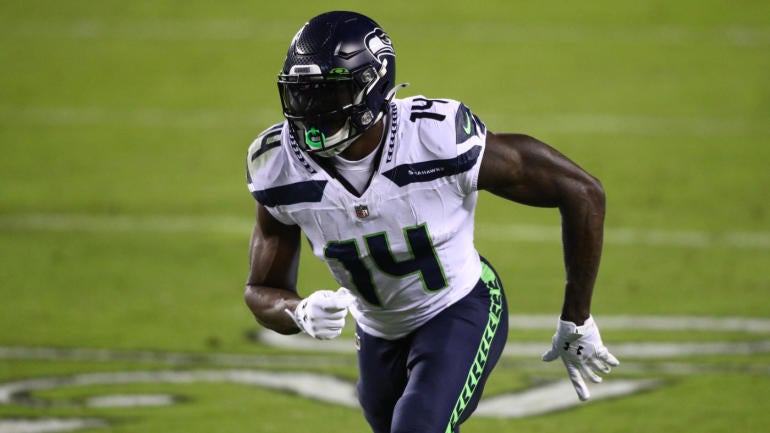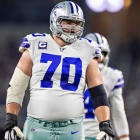
The 2011 Collective Bargaining Agreement drastically reduced salaries for early first-round picks by implementing a rookie wage scale. It also changed the timing for when draft picks could sign contract extensions. Draft pick contracts can't be renegotiated until the conclusion of a player's third NFL regular season. This means 2019 draftees like Cardinals quarterback Kyler Murray, who was the first overall pick, aren't eligible to sign new deals until Jan. 10, 2022.
Prior to the 2011 CBA, draft picks could sign extensions after two NFL seasons. The 2010 draftees were the last group to get extremely early deals before the rule change. In 2012, the Patriots made 2010 second-round pick Rob Gronkowski and 2010 fourth-round pick Aaron Hernandez the NFL's two highest-paid tight ends. Gronkowski and Hernandez signed six- and five-year extensions, respectively. Cardinals inside linebacker Daryl Washington, a 2010 second-round pick, signed a four-year extension right before the start of the 2012 regular season.
Antonio Brown, a 2010 sixth-round pick, was the beneficiary of the Steelers and restricted free agent Mike Wallace's contract stalemate. Once there was a contract impasse with Wallace, the Steelers gave Brown a five-year extension. Brown had his first 1,000-receiving-yard season in 2010 as a second-year player.
The 49ers made NaVorro Bowman, a 2010 third-round pick, one of the NFL's five highest-paid inside linebackers during the middle of his third NFL season. Bowman signed a five-year extension.
Four-year deals in the first round, before the rookie wage scale was implemented, were virtually nonexistent. Most first-rounders got five-year deals, except quarterbacks selected early in the draft, such as Matthew Stafford in 2009 and Sam Bradford in 2010, who signed six-year contracts.
Several 2019 draftees who may have already gotten paid if still allowed have been identified based on team conventions and circumstances. First-round picks wouldn't have reaped the benefit of the earlier paydays.
There wouldn't have been any urgency for the Cardinals to reward Murray like Washington. Early first-round picks used to be paid like Pro Bowlers before playing a down in the NFL.
Bradford's six-year contract as 2010's first overall pick had a base value of $78 million where $50 million was fully guaranteed. He was the NFL's 10th-highest-paid quarterback as a rookie. Stafford, 2009's top pick, was the league's eighth-highest-paid quarterback as a first-year player.
A continuation of this trend where Murray had a similar place in the quarterback salary hierarchy would have put his six-year rookie contract in the $25-million to $27-million-per-year range. Instead, Murray signed a fully guaranteed four-year, $35,158,644 contract with the Cardinals having a fifth-year option for 2023, which surely will be exercised in the upcoming offseason.
Maxx Crosby, EDGE, Raiders
The Raiders selected a player in the 2019 NFL Draft to consistently put pressure on opposing quarterbacks. It was expected to be fourth overall pick Clelin Ferrell instead of a fourth-round pick.
Crosby easily leads the NFL with 66 quarterback pressures (combined sacks, quarterback hurries and quarterback hits), according to Pro Football Focus. Browns defensive end Myles Garrett, the NFL's third-highest-paid defensive player at $25 million per year, is second in the league with 54. Steelers edge rusher T.J. Watt is the NFL's highest-paid non-quarterback with the four-year, $112.011 million extension averaging $28,002,750 per year he signed as the regular season was about to begin. He has 28 quarterback pressures this season.
The Raiders demonstrated a willingness to pay highly productive younger players early in 2019. Tight end Darren Waller was given a new deal during that season when he had two years of service for free agency. He was going to be a restricted free agent in 2020. A second-round tender would have been likely. Waller signed through the 2023 season in which he gave up three unrestricted free agent years valued at $9,013,668 per year.
Similar contract timing, middle of the third season, may have occurred with Crosby because he has been a nightmare for opposing quarterbacks this year. There are 10 pass-rushers with contracts averaging at least $20 million per year. It may just be a matter of time before Crosby joins that club with the type of season he is having.
DK Metcalf, WR, Seahawks
The Seahawks gave wide receiver Tyler Lockett a four-year, $69.2 million extension averaging $17.3 million per year in early April. The deal has $37 million in guarantees, of which $21 million was fully guaranteed at signing. It may have been prudent for Seattle to address the contract inequity between Lockett and Metcalf sooner rather than later in a similar fashion since it would have been permissible. The 2019 second-round pick emerged as one of the NFL's most dangerous receiving threats last season. Metcalf caught 83 passes for a franchise-record 1,303 yards with 10 touchdowns in 2020.
Elgton Jenkins, OL, Packers
Jenkins might have been the beneficiary of Green Bay's contract stalemate with All-Pro wide receiver Davante Adams, who is in a contract year, and losing All-Pro center Corey Linsley in free agency. A new Jenkins deal might have also been a way to demonstrate offensive continuity to reigning NFL MVP Aaron Rodgers during his offseason rift with the Packers.
Jenkins is one of the rare offensive linemen who can play any position on the offensive line. He earned Pro Bowl honors last season at left guard. Jenkins was playing left tackle at a Pro Bowl level filling in for David Bakhtiari, who has been recovering from reconstructive knee surgery, when he tore the ACL in his left knee during last Sunday's 34-31 loss to the Vikings. It remains to be seen if the injury will change the actual timing on a new deal since 2022 is a contract year, and he may not return to action until the early to middle part of next season if Bakhtiari is any indication. Bakhtiari's ACL tear occurred at the end of the 2020 regular season.
Jenkins was at a minimum set to become one of the NFL's highest-paid offensive guards in the upcoming offseason. Joe Thuney sets this market with the five-year, $80 million contract with $46.89 million of guarantees he received from the Chiefs in free agency this year. The most recent data points in the offensive guard market are the extensions the Browns recently gave Joel Bitonio and Wyatt Teller. Bitonio's three-year extension ties Thuney as the league's highest-paid offensive guard at $16 million per year while Teller's four-year extension is for $14.2 million per year. Jenkins would be justified in insisting on a premium because of his versatility.
Deebo Samuel, WR, 49ers
Samuel couldn't build upon an impressive 2019 debut campaign in 2020 because of an offseason left foot fracture and hamstring injuries. Since this season has been a different story, a midseason extension like Bowman's wouldn't have been out of the question. Samuel is having an All-Pro-caliber 2021 season. He is second in the NFL with 99.4 receiving yards per game and fourth with 18.1 yards per catch. His 525 yards after catch are the most in the NFL. The most lucrative wide receiver deal signed in 2021 belongs to Kenny Golladay. He received a four-year, $72 million contract worth a maximum of $76 million with incentives from the Giants in free agency. Samuel surely would have been looking to top this deal.
Jake Bailey, P, Patriots
New England's uncharacteristic free agency spending spree may have extended to one of their 2019 fifth-round picks. Bailey earned All-Pro honors in 2020 after leading the NFL with a 45.6 yard net punting average. The four-year extension averaging $2.9 million per year Colts punter Rigoberto Sanchez, who was undrafted in 2017, signed in 2019 after his second NFL season would seem to be most applicable.



























